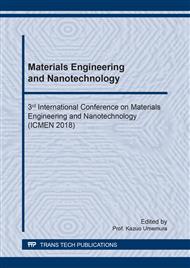p.14
p.20
p.25
p.31
p.37
p.42
p.47
p.53
p.58
Extraction of Nanocellulose from Dried Rubber Tree Leaves by Acid Hydrolysis
Abstract:
Nanocellulose were extracted from dried rubber tree leaves by acid hydrolysis. The dried rubber tree leaves were treated by the alkali and bleaching process to obtain the bleached cellulose powder. Acid hydrolysis from sulfuric acid (H2SO4) at different concentrations (35 wt.% to 65 wt.%) was performed to obtain the nanocellulose. The extracted nanocellulose were characterized by the transmission electron microscope (TEM), atomic force microscope (AFM), Fourier transform infrared spectroscopy (FTIR) and X-ray powder diffraction (XRD). The produced nanocellulose exhibited rod-like shaped cellulose nanocrystals (CNCs), however, the CNCs structure and crystallinity depended on the H2SO4 concentration. It was revealed that the higher H2SO4 concentration led to the shorter CNCs lengths. In addition, the crystallinity was generally found to increase with increasing acid concentration treatments but slightly reduce at 65 wt.% of H2SO4.
Info:
Periodical:
Pages:
37-41
Citation:
Online since:
October 2018
Keywords:
Price:
Сopyright:
© 2018 Trans Tech Publications Ltd. All Rights Reserved
Share:
Citation:


